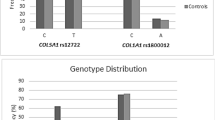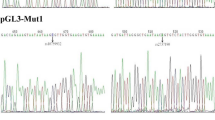Abstract
Lungs are the central organ affected and targeted by Mycobacterium tuberculosis and immune processes in the lung are of critical importance in the pathogenesis of tuberculosis. A major lung defense against invading pathogens is provided by surfactant protein A, a multi-chain protein encoded by the SFTPA1 and SFTPA2 genes. Here, we investigated polymorphisms in the SFTPA1 and SFTPA2 genes for association with tuberculosis in 181 Ethiopian families comprising 226 tuberculosis cases. Four polymorphisms, SFTPA1 307A, SFTPA1 776T, SFTPA2 355C, and SFTPA2 751C, were associated with tuberculosis (P=0.00008; P=0.019, P=0.029 and P=0.042, respectively). Additional subgroup analysis in male, female and more severely affected patients provided evidence for SFTPA1/2-covariate interaction. Finally, out of five intragenic haplotypes identified in the SFTPA1 gene and nine identified in the SFTPA2 gene, 1A 3 was most significantly associated with tuberculosis susceptibility (P=0.026). These findings suggest that SFTPA1 and SFTPA2 modify the risk of tuberculosis susceptibility and that this risk is influenced by additional covariates.

Similar content being viewed by others
References
Blau H, Riklis S, Van Iwaarden JF, McCormack FX, Kalina M (1997) Nitric oxide production by rat alveolar macrophages can be modulated in vitro by surfactant protein A. Am J Physiol 272:L1198–L1204
Borron P, McIntosh JC, Korfhagen TR, Whitsett JA, Taylor J, Wright JR (2000) Surfactant-associated protein A inhibits LPS-induced cytokine and nitric oxide production in vivo. Am J Physiol Lung Cell Mol Physiol 278:L840–L847
Cartegni L, Chew SL, Krainer AR (2002) Listening to silence and understanding nonsense: exonic mutations that affect splicing. Nat Rev Genet 3:285–298
Casanova JL, Abel L (2002) Genetic dissection of immunity to mycobacteria: the human model. Annu Rev Immunol 20:581–620
Chu AJ, Rooney SA (1985) Estrogen stimulation of surfactant synthesis. Pediatr Pulmonol 1:S110–S411
Corbett EL, Watt CJ, Walker N, Maher D, Williams BG, Raviglione MC, Dye C (2003) The growing burden of tuberculosis: global trends and interactions with the HIV epidemic. Arch Intern Med 163:1009–1021
DiAngelo S, Lin Z, Wang G, Phillips S, Ramet M, Luo J, Floros J (1999) Novel, non-radioactive, simple and multiplex PCR-cRFLP methods for genotyping human SP-A and SP-D marker alleles. Dis Markers 15:269–281
Downing JF, Pasula R, Wright JR, Twigg HL 3rd, Martin WJ 2nd (1995) Surfactant protein A promotes attachment of Mycobacterium tuberculosis to alveolar macrophages during infection with human immunodeficiency virus. Proc Natl Acad Sci USA 92:4848–4852
Dye C, Williams BG, Espinal MA, Raviglione MC (2002) Erasing the world’s slow stain: strategies to beat multidrug-resistant tuberculosis. Science 295:2042–2046
El-Etr SH, Cirillo JD (2001) Entry mechanisms of mycobacteria. Front Biosci 6:D737–D747
Floros J, Lin HM, Garcia A, Salazar MA, Guo X, DiAngelo S, Montano M, Luo J, Pardo A, Selman M (2000) Surfactant protein genetic marker alleles identify a subgroup of tuberculosis in a Mexican population. J Infect Dis 182:1473–1478
Floros J, Fan R, Diangelo S, Guo X, Wert J, Luo J (2001a) Surfactant protein (SP) B associations and interactions with SP-A in white and black subjects with respiratory distress syndrome. Pediatr Int 43:567–576
Floros J, Fan R, Matthews A, DiAngelo S, Luo J, Nielsen H, Dunn M, Gewolb IH, Koppe J, van Sonderen L, Farri-Kostopoulos L, Tzaki M, Ramet M, Merrill J (2001b) Family-based transmission disequilibrium test (TDT) and case-control association studies reveal surfactant protein A (SP-A) susceptibility alleles for respiratory distress syndrome (RDS) and possible race differences. Clin Genet 60:178–187
Garcia-Verdugo I, Wang G, Floros J, Casals C (2002) Structural analysis and lipid-binding properties of recombinant human surfactant protein a derived from one or both genes. Biochemistry 41:14041–14053
Gardai SJ, Xiao YQ, Dickinson M, Nick JA, Voelker DR, Greene KE, Henson PM (2003) By binding SIRPalpha or calreticulin/CD91, lung collectins act as dual function surveillance molecules to suppress or enhance inflammation. Cell 115:13–23
Gold JA, Hoshino Y, Tanaka N, Rom WN, Raju B, Condos R, Weiden MD (2004) Surfactant protein A modulates the inflammatory response in macrophages during tuberculosis. Infect Immun 72:645–650
Haagsman HP (2002) Structural and functional aspects of the collectin SP-A. Immunobiology 205:476–489
Haataja R, Ramet M, Marttila R, Hallman M (2000) Surfactant proteins A and B as interactive genetic determinants of neonatal respiratory distress syndrome. Hum Mol Genet 9:2751–2760
Haataja R, Marttila R, Uimari P, Lofgren J, Ramet M, Hallman M (2001) Respiratory distress syndrome: evaluation of genetic susceptibility and protection by transmission disequilibrium test. Hum Genet 109:351–355
Hoover RR, Floros J (1998) Organization of the human SP-A and SP-D loci at 10q22-q23. Physical and radiation hybrid mapping reveal gene order and orientation. Am J Respir Cell Mol Biol 18:353–362
Hussain S, Wright JR, Martin WJ (2003) Surfactant protein A decreases nitric oxide production by macrophages in a tumor necrosis factor-alpha-dependent mechanism. Am J Respir Cell Mol Biol 28:520–527
Kala P, Ten Have T, Nielsen H, Dunn M, Floros J (1998) Association of pulmonary surfactant protein A (SP-A) gene and respiratory distress syndrome: interaction with SP-B. Pediatr Res 43:169–177
Karinch AM, deMello DE, Floros J (1997) Effect of genotype on the levels of surfactant protein A mRNA and on the SP-A2 splice variants in adult humans. Biochem J 321:39–47
Kersteen EA, Raines RT (2001) Contribution of tertiary amides to the conformational stability of collagen triple helices. Biopolymers 59:24–28
Kremlev SG, Phelps DS (1994) Surfactant protein A stimulation of inflammatory cytokine and immunoglobulin production. Am J Physiol 267:L712–L719
Kremlev SG, Umstead TM, Phelps DS (1997) Surfactant protein A regulates cytokine production in the monocytic cell line THP-1. Am J Physiol 272:L996–L1004
Lofgren J, Ramet M, Renko M, Marttila R, Hallman M (2002) Association between surfactant protein A gene locus and severe respiratory syncytial virus infection in infants. J Infect Dis 185:283–289
Madan T, Saxena S, Murthy KJ, Muralidhar K, Sarma PU (2002) Association of polymorphisms in the collagen region of human SP-A1 and SP-A2 genes with pulmonary tuberculosis in Indian population. Clin Chem Lab Med 40:1002–1008
Madsen J, Tornoe I, Nielsen O, Koch C, Steinhilber W, Holmskov U (2003) Expression and localization of lung surfactant protein A in human tissues. Am J Respir Cell Mol Biol 29:591–597
Malik S, Schurr E (2002) Genetic susceptibility to tuberculosis. Clin Chem Lab Med 40:863–868
Marttila R, Haataja R, Ramet M, Pokela ML, Tammela O, Hallman M (2003) Surfactant protein A gene locus and respiratory distress syndrome in Finnish premature twin pairs. Ann Med 35:344–352
Palaniyar N, Ikegami M, Korfhagen T, Whitsett J, McCormack FX (2001) Domains of surfactant protein A that affect protein oligomerization, lipid structure and surface tension. Comp Biochem Physiol A Mol Integr Physiol 129:109–127
Pasula R, Wright JR, Kachel DL, Martin WJ 2nd (1999) Surfactant protein A suppresses reactive nitrogen intermediates by alveolar macrophages in response to Mycobacterium tuberculosis. J Clin Invest 103:483–490
Rabinowitz D, Laird N (2000) A unified approach to adjusting association tests for population admixture with arbitrary pedigree structure and arbitrary missing marker information. Hum Hered 50:211–223
Ramet M, Haataja R, Marttila R, Floros J, Hallman M (2000) Association between the surfactant protein A (SP-A) gene locus and respiratory-distress syndrome in the Finnish population. Am J Hum Genet 66:1569–1579
Rosseau S, Hammerl P, Maus U, Gunther A, Seeger W, Grimminger F, Lohmeyer J (1999) Surfactant protein A down-regulates proinflammatory cytokine production evoked by Candida albicans in human alveolar macrophages and monocytes. J Immunol 163:4495–4502
Sano H, Sohma H, Muta T, Nomura S, Voelker DR, Kuroki Y (1999) Pulmonary surfactant protein A modulates the cellular response to smooth and rough lipopolysaccharides by interaction with CD14. J Immunol 163:387–395
Saxena S, Madan T, Shah A, Muralidhar K, Sarma PU (2003) Association of polymorphisms in the collagen region of SP-A2 with increased levels of total IgE antibodies and eosinophilia in patients with allergic bronchopulmonary aspergillosis. J Allergy Clin Immunol 111:1001–1007
Schaid DJ (1996) General score tests for associations of genetic markers with disease using cases and their parents. Genet Epidemiol 13:423–449
Song M, Phelps DS (2000) Interaction of surfactant protein A with lipopolysaccharide and regulation of inflammatory cytokines in the THP-1 monocytic cell line. Infect Immun 68:6611–6617
Voss T, Eistetter H, Schafer KP, Engel J (1988) Macromolecular organization of natural and recombinant lung surfactant protein SP 28–36. Structural homology with the complement factor C1q. J Mol Biol 201:219–227
Voss T, Melchers K, Scheirle G, Schafer KP (1991) Structural comparison of recombinant pulmonary surfactant protein SP-A derived from two human coding sequences: implications for the chain composition of natural human SP-A. Am J Respir Cell Mol Biol 4:88–94
Wang G, Phelps DS, Umstead TM, Floros J (2000) Human SP-A protein variants derived from one or both genes stimulate TNF-alpha production in the THP-1 cell line. Am J Physiol Lung Cell Mol Physiol 278:L946–L954
Wang G, Umstead TM, Phelps DS, Al-Mondhiry H, Floros J (2002) The effect of ozone exposure on the ability of human surfactant protein a variants to stimulate cytokine production. Environ Health Perspect 110:79–84
Wang G, Guo X, Floros J (2003) Human SP-A 3′-UTR variants mediate differential gene expression in basal levels and in response to dexamethasone. Am J Physiol Lung Cell Mol Physiol 284:L738–L748
Author information
Authors and Affiliations
Corresponding author
Rights and permissions
About this article
Cite this article
Malik, S., Greenwood, C., Eguale, T. et al. Variants of the SFTPA1 and SFTPA2 genes and susceptibility to tuberculosis in Ethiopia. Hum Genet 118, 752–759 (2006). https://doi.org/10.1007/s00439-005-0092-y
Received:
Accepted:
Published:
Issue Date:
DOI: https://doi.org/10.1007/s00439-005-0092-y




